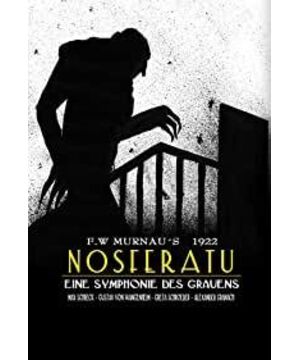From a historical point of view, the shining point of "Nosferatu" is not just the first vampire film. Its contribution to the history of film and the reinterpretation of expressionism has weakened the "Dr. Caligari's" The sharp lines throughout the film express the ups and downs of the characters in "The Cabin". "Nosferatu" only uses expressionism in a small amount. The actor's body follows the direction of the "architectural line", and the vampire silhouette on the wall creates an atmosphere of horror. This also found a new direction for the short-lived German expressionism. Expressionism from 1919 to 1924 did not produce a large number of masterpieces in five years, and the progress only stopped in the formal language of images, German romance Doctrine is still permeating the inner layer of the film. The new solution proposed by "Nosferatu" is to extract the essence of expressionism and replace the "false atmosphere" of monotonous violence from performance to set.
The story of "Nosferatu" filmed by Murnau in 1922 is already well known to everyone. Although from the current perspective, the rough picture and somewhat crappy plot made the film’s viewing ability a lot of discounts, but gradually got used to it. After the performance of silent films, "Nosferatu" made me experience a different kind of light and shadow feast. In Murnau’s lens, Nosferatu is stiff and possesses the power to control the movement of objects The 79 version of the vampire will also take the coffin under his arm, which seems to be a play), the body maintains a strange proportion-this proportion is not the beauty that ordinary people can accept, but you can feel the coldness of the vampire Breath, Nosferatu is just a bloodthirsty icy creature, but it also has the pessimistic temperament of this character and the hope of pursuing death. Due to historical reasons, the ability of Nosferatu to suck blood in the film is not the whole point of the story. "The Rat King", "Plague Carrier", and the plague brought by the ship full of rats also enveloped the film with a terrible atmosphere. , The setting that ultimately died of Allen and Liming is slightly thinner. In the remake of "Nosferatu" in 1979, Herzog perfected the script and changed the comedy to the ending of the rebirth of a vampire and the ending of Lucy's dedication of life, which also enriched the connotation of the image of Nosferatu. But the horror atmosphere of Murnau was lost, but Herzog’s madman partner Claude Kinsky’s performance was really remarkable. He played a lonely life for hundreds of years, pursuing death and seeking love. The image of a neurotic vampire is no worse than the performance of the barbarian in "Aguirre, God's Wrath". Compared with the vampires who were beautified in the later "Four Hundred Years of Surprise" and "Twilight"-handsome, lonely, and full of charm, the early vampires are closer to the original image setting, a struggling on the edge of immortality. Vampires are far more attractive to me than charming sick youths.
When it comes to vampires, in addition to Nosferatu, I have to mention "Vampyr" (Vampyr) filmed by Dreyer in 1932. This is Dreyer's first sound film. The plot is mixed with mysticism and conjecture. Symptom, tells the story of a young man wandering between dreams and reality, lost between reality and illusion. The image of vampire in this film is no longer so clear, without the white-faced fangs in "Nosferatu" Old earl, the victim's neck won't have two wounds, and even the real existence of vampires is questionable. The film focuses more on the scenes seen by young people. The tortuous and complicated space, the shadows enslaved by vampires are separated from the body, and the victims will become vampires. The most shocking scene is undoubtedly the young people discovering that the vampire in the coffin is From then on, the film has gradually deepened from a vampire movie to a masterpiece of delusions and hallucinations. The vampire in the film comes from an old woman abandoned by God, crawling out of the grave and sucking human blood. The way to eliminate vampires is no longer sunlight, but instead of using an iron rod to penetrate the vampire's heart and nail it to the ground, so as to relieve the vampire and its victims from the bad luck.
It can be seen from these three films that the suspense about the living habits of vampires always floats above the film. If this mystery is not solved, there will be nowhere to test the specific solution. Legends and books are often the way to obtain such texts. Ambiguous points are like sucking the blood of a young girl so that Nosferatu cannot feel the dawn. Using sunlight to kill a vampire is like nailing a vampire to the ground with violence. More suspense comes from the creation of the image of the vampire, how to combine the violent vampire lens with the elegant and old-fashioned image of the old nobleman, and how to define the cause of the vampire's behavior and the external manifestation of the inner struggle. Ancient vampire movies are good at solving the first problem with black and white art films, but they are still unable to perfect the fullness of the vampire image due to silent films or other factors. Once modern vampire movies are colored, they lose most of the mystery and elegance of vampires. With the development and commercialization of film aesthetics, the image of vampires has undergone many changes. The genre of horror films has gradually been weakened, and the selling point has also focused on the poignant love between vampires and humans. This is destined to be an irreversible process, but it is really impossible to distinguish good from bad.
Finally, it ends with a line: "Time is an abyss, as deep as a thousand nights. It is terrible not to grow old when the century changes."
View more about Nosferatu reviews








